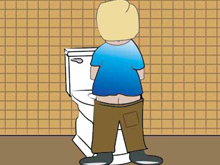Health Topics
-
Healthy Living
-
|
|
January 2011
|
Pee Pressure
SPOTTING URINARY TRACT INFECTIONS IN CHILDREN |
| Dr Anand Alladi |
| |
 |
Urinary Tract Infection (UTI) is a common problem in infants and young children. It affects about two to five percent of all small children. Boys are affected more in the neonatal period, and girls are affected more beyond six months of age. The chances of recurrent infection range from one to three percent, and this is more so in girls. |
Tract Distribution
The urinary tract includes the kidneys, the ureters (the tubes draining the urine to the bladder), the urinary bladder and the urethra. Urinary tract infections generally could mean infections of the bladder (cystitis) or that affecting the kidneys (pyelonephritis). The latter is more serious, and generally implies that there is some underlying structural problem. Almost a third to half of infants who are inflicted with urinary infection are likely to have an abnormal urinary tract, predisposing them to infections. Such children need to be evaluated to protect further infections and damage to their kidneys.
Baby Signs
These symptoms of a urinary tract infection depend on the age of the child and whether the child has bladder or kidney infection. In small babies these could be signs:
- Fever.
- Irritability.
- Vomiting.
- Convulsions.
- Lethargy.
- Smelly urine.
Older Warnings
Older children may complain of:
- Increased frequency in urination.
- Inability to hold urine.
- Burning sensation while voiding.
- Lower abdominal or flank pain.
- Recent onset of bed wetting.
The bacteria, which cause urinary tract infections, may reach the kidneys through the blood or ascend up the urinary tract from the skin around the anus and genitals.
The Guilty Ones
The causes of urinary infection may be:
- Any abnormality in the urinary tract .
- Increased tendency to get infections .
- Improper voiding habits like holding urine for long time, incomplete voiding or incomplete emptying of the bladder.
Being Sure
The diagnosis of a urinary infection is made by conducting a microscopic examination of a urine sample, and growing the bacteria present in the urine in a medium. The urine sample for testing is collected by applying a clean collecting bag. However, the best way of collecting a sample is by taking it directly from the bladder with a syringe from the lower abdomen, which is usually done by a doctor or a trained nurse. This is a more reliable way of sampling.
Making Things Better
The infection is treated with a course of antibiotics for a period of five to seven days at least. Sometimes, the antibiotic may have to be changed depending on the culture report. Occasionally, the infection may be very severe, and may require intravenous antibiotics and rarely, additional catheter drainage of urine to control the infection.
After the infection is treated, the child would need to undergo some tests to detect or rule out predisposing conditions. The preliminary test is an ultrasonography of the kidneys and bladder. Further investigations are a Voiding Cysto Urethro Graphy (VCUG) wherein a small plastic tube is inserted into the bladder, radio opaque dye instilled, and X rays taken while the child is voiding. The other test required is a nuclear scan called DMSA Renogram. |
 |
Dr Anand Alladi is Senior Consultant – Paediatric Surgery and Urology at Apollo Hospitals, Bangalore |
|
|